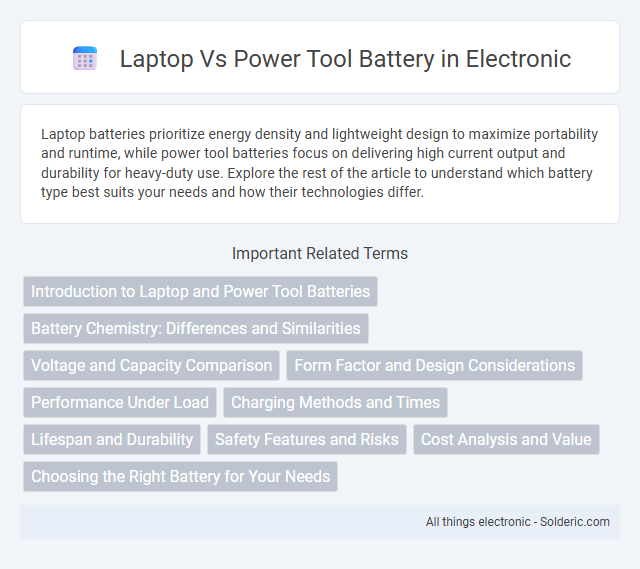Laptop batteries prioritize energy density and lightweight design to maximize portability and runtime, while power tool batteries focus on delivering high current output and durability for heavy-duty use. Explore the rest of the article to understand which battery type best suits your needs and how their technologies differ.
Comparison Table
| Feature | Laptop Battery | Power Tool Battery |
|---|---|---|
| Battery Type | Lithium-ion (Li-ion) or Lithium Polymer (Li-Po) | Lithium-ion (Li-ion), Nickel-Cadmium (NiCd), or Nickel-Metal Hydride (NiMH) |
| Voltage Range | Typically 10.8V to 15.2V | Typically 12V to 60V depending on tool |
| Capacity (mAh) | 2000-6000 mAh | 1500-6000 mAh or higher |
| Energy Density | High energy density optimized for compact size | High discharge rate for power tools, moderate energy density |
| Cycle Life | 300-1000 charge cycles | 300-1500 charge cycles, varies by chemistry |
| Weight | Lightweight for portability | Heavier to support high power output |
| Charging Time | 1-3 hours | 30 minutes to 1 hour with fast chargers |
| Main Use | Powering laptops, tablets, portable electronics | Powering drills, saws, garden tools, heavy-duty equipment |
| Safety Features | Overcharge, over-discharge, temperature protection | Overcurrent, thermal cut-off, short-circuit protection |
Introduction to Laptop and Power Tool Batteries
Laptop batteries typically use lithium-ion technology designed for consistent, long-lasting energy output to support continuous computing tasks. Power tool batteries often utilize lithium-ion or nickel-cadmium cells optimized for high current delivery and durability under heavy-duty usage. Understanding the differences in chemistry, capacity, and discharge rates helps you choose the right battery for your device's performance and lifespan needs.
Battery Chemistry: Differences and Similarities
Laptop batteries primarily use lithium-ion (Li-ion) chemistry for high energy density, lightweight design, and consistent voltage output, enabling longer device runtime and faster charging. Power tool batteries often utilize lithium-ion or nickel-cadmium (NiCd) chemistries, where lithium-ion offers better energy density and lifespan, while NiCd provides superior durability under heavy load and extreme temperatures. Both battery types feature rechargeable cells with built-in protection circuits to prevent overcharging and overheating, yet power tool batteries are optimized for high current discharge and rugged use compared to the stable, lower current demands of laptop batteries.
Voltage and Capacity Comparison
Laptop batteries typically operate between 10.8V to 15.4V with capacities ranging from 40Wh to 100Wh, optimized for prolonged energy delivery and lightweight design. Power tool batteries, often rated at higher voltages like 18V to 20V, offer capacities measured in ampere-hours (Ah), commonly between 2Ah and 5Ah, designed for delivering high current bursts necessary for demanding tasks. Understanding these differences ensures your devices receive appropriate power, maximizing efficiency and battery life.
Form Factor and Design Considerations
Laptop batteries are designed with slim, lightweight form factors to fit within compact devices, prioritizing portability and heat management through integrated cooling solutions. Power tool batteries feature robust, often modular designs with high-capacity lithium-ion cells to deliver peak power and durability, optimized for quick swapping and resistance to harsh worksite conditions. The contrasting design considerations reflect the laptops' emphasis on sleekness and energy efficiency versus power tools' focus on ruggedness and sustained performance.
Performance Under Load
Laptop batteries maintain consistent voltage under typical usage, optimizing performance for tasks like video editing and gaming, but may experience voltage drops under heavy, sustained loads. Power tool batteries, often lithium-ion or nickel-cadmium, deliver high current bursts necessary for demanding applications such as drilling or cutting, ensuring efficient torque and power retention. You should consider the load requirements of your device to match battery type for optimal performance under stress.
Charging Methods and Times
Laptop batteries typically use lithium-ion cells with fast charging technologies like USB-C Power Delivery, enabling a full charge within 1 to 2 hours depending on the wattage. Power tool batteries, often lithium-ion or nickel-cadmium, rely on specialized chargers designed for rapid replenishment, with charging times ranging from 30 minutes to 1 hour for high-end models. Your choice should consider the balance between the convenience of quick charging in power tools and the more gradual, controlled charging required by laptops to preserve battery health.
Lifespan and Durability
Laptop batteries typically have a lifespan of 300 to 500 full charge cycles, maintaining optimal performance for around 2 to 4 years under moderate use. Power tool batteries, especially lithium-ion types, often endure 500 to 1,000 charge cycles and are built to withstand harsher conditions like impacts, temperature fluctuations, and heavy usage. The enhanced durability of power tool batteries makes them better suited for rugged environments, while laptop batteries prioritize stable energy efficiency and longer discharge periods.
Safety Features and Risks
Laptop batteries incorporate advanced safety features such as overcharge protection, temperature sensors, and short-circuit prevention to minimize risks during daily use. Power tool batteries, often designed for high power output, include robust thermal management and impact-resistant casings to handle rugged conditions but can pose higher risks like overheating and chemical leaks if damaged. Understanding these differences helps you choose the safest battery type suited to your specific needs and usage environment.
Cost Analysis and Value
Laptop batteries generally cost between $50 to $150, while power tool batteries often range from $40 to $120 depending on brand and capacity. Power tool batteries provide higher energy output for heavy-duty usage, offering greater value in durability and performance per dollar spent. Laptop batteries prioritize longer cycle life and energy efficiency, making them more cost-effective for extended daily use in portable computing.
Choosing the Right Battery for Your Needs
Selecting the right battery depends on the specific device's power requirements and usage patterns. Laptop batteries prioritize energy density and longevity to support prolonged computing tasks, while power tool batteries are designed for high current output and durability under heavy loads. Evaluating capacity (mAh or Ah), voltage compatibility, and recharge cycles ensures optimal performance and safety for both laptops and power tools.
Laptop vs Power tool battery Infographic

 solderic.com
solderic.com